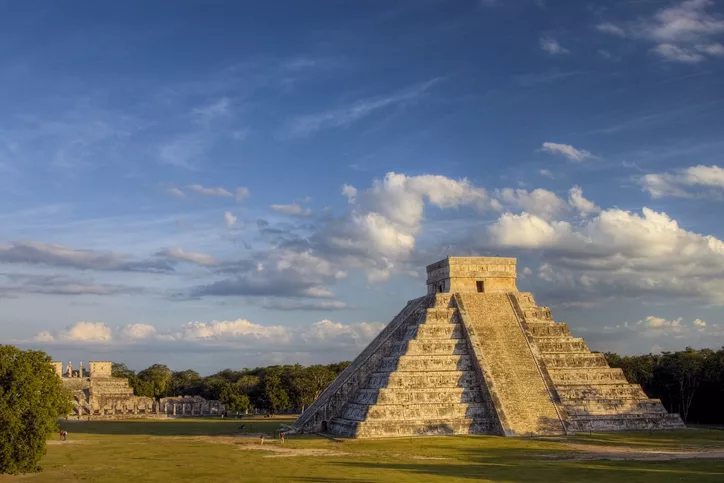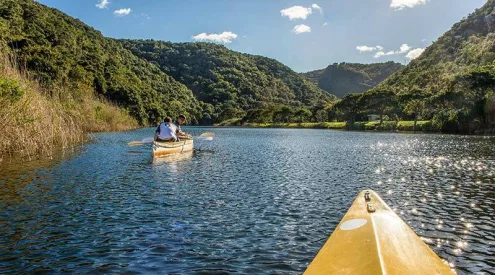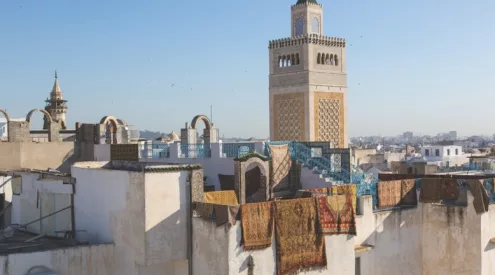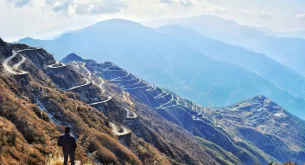Chichen-Itza, a sacred site nestled within the Yucatán peninsula, stands as a testament to the rich history and cultural heritage of the Mayan people. Over nearly a millennium, diverse cultures have contributed to the legacy of this remarkable city. It is within the stone monuments and artistic creations that the Maya and Toltec worldviews come to life. This fusion of Mayan architectural techniques with elements from central Mexico has established Chichen-Itza as a preeminent symbol of the Mayan-Toltec civilization in the Yucatán region. Several enduring structures, such as the Warriors’ Temple, El Castillo, and the circular observatory known as El Caracol, have survived the test of time.

Pyramid of Kukulcan, Chichen Itza, Yucatan, Mexico.
Brief historical overview
Chichen-Itza’s origins trace back to the Classic period, situated near natural cenotes (cavities) that served as a vital water source. The settlement’s founding dates vary, with some historical accounts suggesting 415-35 A.D., while others point to 455 A.D. During this era, Chichen Viejo, a sector of the city, boasted significant monuments like the Nunnery, the Church, Akab Dzib, Chichan Chob, the Temple of the Panels, and the Temple of the Deer. These structures, constructed between the 6th and 10th centuries, reflect the distinctive Maya architectural style prevalent in the northern and southern Puuc hills.
The second phase of Chichen-Itza’s history witnessed the arrival of Toltec warriors from the Mexican plateau during the 10th century. According to popular accounts, Ce Acatl Topiltzin Quetzalcoatl, known as Kukulkan to the Maya, assumed control of the city between 967 A.D. and 987 A.D. This marked the beginning of a fascinating period of cultural exchange, blending Maya and Toltec traditions, evident in the city’s architectural features.
Chichen-Itza’s significance transcends its role as an archaeological site; it also represents a testament to the complex process of acculturation between distinct Mesoamerican cultures. Notable examples include the Caracol, a circular observatory featuring a spiral staircase, and El Castillo (the Temple of Kukulkan). Surrounding El Castillo, visitors can explore terraces that host monumental complexes, such as the Great Ball Court, Tzompantli (the Skull Wall), the Jaguar Temple, and the House of Eagles to the northwest. To the northeast, one can discover the Temple of the Warriors, the Group of the Thousand Columns, the Market, and the Great Ball Court. Additionally, the Tomb of the High Priest graces the southwest.
However, after the 13th century, Chichen-Itza saw a decline in monumental construction, with few major structures added to the cityscape until around 1440 A.D. Remarkably, it wasn’t until 1841 A.D. that the site underwent its first excavation.
World Heritage Significance
Chichen-Itza’s monuments, particularly those in the northern group like the Great Ball Court, the Temple of Kukulkan, and the Temple of the Warriors, stand as masterpieces of Mesoamerican architecture. Their beauty, precise proportions, intricate construction, and ornate sculptures contribute to their undisputed significance.
The influence of Chichen-Itza extended far beyond its borders, shaping the culture of the Yucatan region from the 10th to the 15th century. It remains the most important archaeological vestige of the Maya-Toltec civilization in Yucatan.
Preservation Challenges
Chichen-Itza faced a period of gradual deterioration after its abandonment in the 15th century until the commencement of excavations more than a century ago. Fortunately, the use of high-quality materials and advanced construction techniques by the Maya ensured the preservation of its architectural, sculptural, and pictorial essence over the centuries.
While Chichen-Itza has maintained its authenticity, concerns have arisen about its use as a venue for unrelated cultural events and their impact on the site’s conservation and authenticity. Ensuring that the site’s character is preserved requires strict enforcement of regulations and protective measures.
Protection and Management
Chichen-Itza enjoys protection under the 1972 Federal Law on Monuments and Archaeological, Artistic, and Historic Zones and was officially declared an archaeological monument in 1986. With daily visitation ranging from 3,500 to 8,000 tourists during the high season, the site necessitates continuous maintenance and vigilance to prevent deterioration.
The management of Chichen-Itza involves two institutions: the National Institute of Anthropology and History (INAH), responsible for site care and conservation, and the Board of Units of Cultural and Tourism Services of the State of Yucatan, created in 1987 to oversee various archaeological sites.
A comprehensive “Management Plan of the Pre-hispanic City of Chichen-Itza” addresses medium and long-term activities, including research, conservation, interpretation, administration, and operation of the site. This plan aims to coordinate efforts among various stakeholders, including the general public.
However, the absence of an emergency plan and long-term conservation monitoring, due to a lack of personnel, poses risks to the site. Addressing these issues, along with protecting against natural disasters and degradation, requires sustained commitment and resources.
Follow us on social media for more travel news, inspiration, and guides. You can also tag us to be featured.
TikTok | Instagram | Facebook | Twitter
















